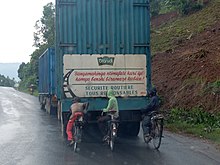Kirundi
| Rundi | |
|---|---|
| Ikirundi | |
| Native to | Burundi |
| Ethnicity | Hutu Tutsi Twa Ganwa |
Native speakers | 13 million (2021)[1] |
| Dialects |
|
| Latin | |
| Official status | |
Official language in | |
| Language codes | |
| ISO 639-1 | rnRundi |
| ISO 639-2 | runRundi |
| ISO 639-3 | runRundi |
| Glottolog | rund1242Rundirund1241Rundi-Kitwa |
JD.62[2] | |
| Person | Umurundi |
|---|---|
| People | Abarundi |
| Language | Ikirundi |
| Country | u Burundi |
Kirundi,also known asRundi,is aBantu languageand thenational languageofBurundi.It is a dialect ofRwanda-Rundidialect continuum that is also spoken inRwandaand adjacent parts ofTanzania(in regions close to Kigoma), theDemocratic Republic of the Congo,Uganda,as well as inKenya.Kirundi ismutually intelligiblewithKinyarwanda,the national language ofRwanda,and the two form parts of the widerdialect continuumknown asRwanda-Rundi.[3]
Kirundi is natively spoken by theHutu,includingBakigaand other related ethnicities, as well asTutsi,TwaandHimaamong others have adopted the language. Neighbouring dialects of Kirundi aremutually intelligiblewithHa,a language spoken in westernTanzania.
Kirundi is one of the languages whereMeeussen's rule,a rule describing a certain pattern of tonal change in Bantu languages, is active.
In 2020, the Rundi Academy was established to help standardize and promote Kirundi.[4]

Phonology
[edit]Consonants
[edit]Although the literature on Rundi agrees on 5 vowels, the number of consonants can vary anywhere from 19 to 26 consonants.[5]The table below is compiled from a survey of academic acceptance of Rundi consonants.[6]
| Labial | Alveolar | Post- alveolar |
Palatal | Velar | Glottal | ||
|---|---|---|---|---|---|---|---|
| Nasal | m | n | ɲ | ŋ | |||
| Plosive | voiceless | p | t | k | |||
| voiced | b | d | ɟ | ɡ | |||
| Affricate | p͡f | t͡s | t͡ʃ | ||||
| Fricative | voiceless | f | s | ʃ | h | ||
| voiced | v | z | ʒ | ||||
| Approximant | j | w | |||||
| Flap | ɾ | ||||||
| Trill | r | ||||||
Vowels
[edit]The table below gives the vowel sounds of Rundi.
| Front | Back | |
|---|---|---|
| Close | i | u |
| Mid | e | o |
| Open | a | |
All five vowels occur inlongandshortforms. The distinction isphonemic.[7]
Tone
[edit]Rundi is atonal language.There are two essential tones in Rundi: high and low (or H and L). Since Rundi has phonemic distinction on vowel length, when a long vowel changes from a low tone to a high tone it is marked as a rising tone. When a long vowel changes from a high tone to a low tone, it is marked as a falling tone.[8]
Rundi is often used in phonology to illustrate examples ofMeeussen's rule[9][10]In addition, it has been proposed that tones can shift by a metrical or rhythmic structure. Some authors have expanded these more complex features of the tonal system noting that such properties are highly unusual for a tone system.[11]
Phonotactics
[edit]Syllable structure in Rundi is considered to be CV, that is having no clusters, no coda consonants, and no complex vowel nuclei. It has been proposed that sequences that are CVV in the surface realization are actually CV in the underlyingdeep structure,with the consonant coalescing with the first vowel.[12]
Consonant harmony
[edit]Rundi has been shown to have properties ofconsonant harmonyparticularly when it comes to sibilants. Meeussen described this harmony in his essay and it is investigated further by others.[13]One example of this harmony is triggered by/ʃ/and/ʒ/and targets the set of/s/and/z/in preceding adjacent stem syllables.
Official use
[edit]
Kirundi was recognized anofficial languagein Burundi by the 1962Constitution of the Kingdom of Burundi.In accordance with the constitution, many Burundian government orders, especially those printed in theBulletin Officiel du Burundifrom 1962 to 1963, were written in both French and Kirundi. After the constitution was suspended in 1966, Kirundi remained ade factoofficial language in the county, though its use in government documents declined.[14]In 1972 Kirundi was adopted as the official language of instruction in Burundian primary schools.[15]
Notes
[edit]- ^RundiatEthnologue(27th ed., 2024)

- ^Jouni Filip Maho, 2009.New Updated Guthrie List Online
- ^KirundiatEthnologue(15th ed., 2005)

- ^Rigumye, Mariette."Longtemps attendue, l'Académie Rundi ouvre sous peu".IWACU(in French).Archivedfrom the original on 2020-11-04.Retrieved2021-09-10.
- ^Zorc & Nibagwire 2007,p. 23.
- ^Zorc & Nibagwire 2007,p. 25.
- ^Meeussen 1959.
- ^de Samie 2009.
- ^Myers 1987.
- ^Philippson 1998.
- ^Goldsmith & Sabimana 1989.
- ^Sagey 1986.
- ^Ntihirageza 1993.
- ^Verdoodt 2011,p. 515.
- ^Weinstein 1976,p. 89.
References
[edit]- Broselow, Ellen; Niyondagara, Alice (Spring 1990)."Feature geometry of Kirundi palatalization".Studies in the Linguistic Sciences.20(1): 71–88.ISSN0049-2388.
- de Samie, Thierry (2009).Dictionnaire français-kirundi(2nd ed.). Paris: L'Harmattan.ISBN978-2-296-09185-6.
- Goldsmith, John; Sabimana, Firmard (1989)."The Kirundi Verb"(PDF).Modèles en tonologie: kirundi et kinyarwanda.Paris: Editions du CNRS.ISBN9782222043232.Archived(PDF)from the original on 2022-11-24.
- Meeussen, A. E. (1959).Essai de grammaire Rundi.Annales du Musée Royal du Congo Belge, Série Sciences Humaines – Linguistique. Vol. 24. Tervuren.
{{cite book}}:CS1 maint: location missing publisher (link) - Myers, Scott P. (1987).Tone and the structure of words in Shona(PhD dissertation). Amherst: University of Massachusetts.ProQuest303602751.
- Ntihirageza, J. (1993).Kirundi Palatization and Sibilant Harmony: Implications for Feature Geometry(Master thesis). Carbondale: Southern Illinois University.
- Philippson, Gérard (1998). "Tone reduction vs. metrical attraction in the evolution of Eastern Bantu tone systems". In Hyman, Larry M.; Kisseberth, Charles W. (eds.).Theoretical Aspects of Bantu Tone.Cambridge University Press. pp. 315–329.ISBN1575860953.
- Sagey, Elizabeth Caroline (1986).The Representation of Features and Relations in Non-Linear Phonology(PDF)(PhD dissertation). Cambridge: MIT.Archived(PDF)from the original on 2005-03-22.
- Verdoodt, A. (2011). "Social and Linguistic Structures of Burundi, a Typical 'Unimodal' Country".Language and Society: Anthropological Issues(reprint ed.). Walter de Gruyter. pp. 509–532.ISBN9783110806489.
- Weinstein, Warren (1976).Historical Dictionary of Burundi.Metuchen, NJ: Scarecrow Press.ISBN9780810809628.
- Zorc, R. David; Nibagwire, Louise (2007).Kinyarwanda and Kirundi Comparative Grammar(PDF).Hyattsville, MD: Dunwoody Press.Archived(PDF)from the original on 2022-07-14.
